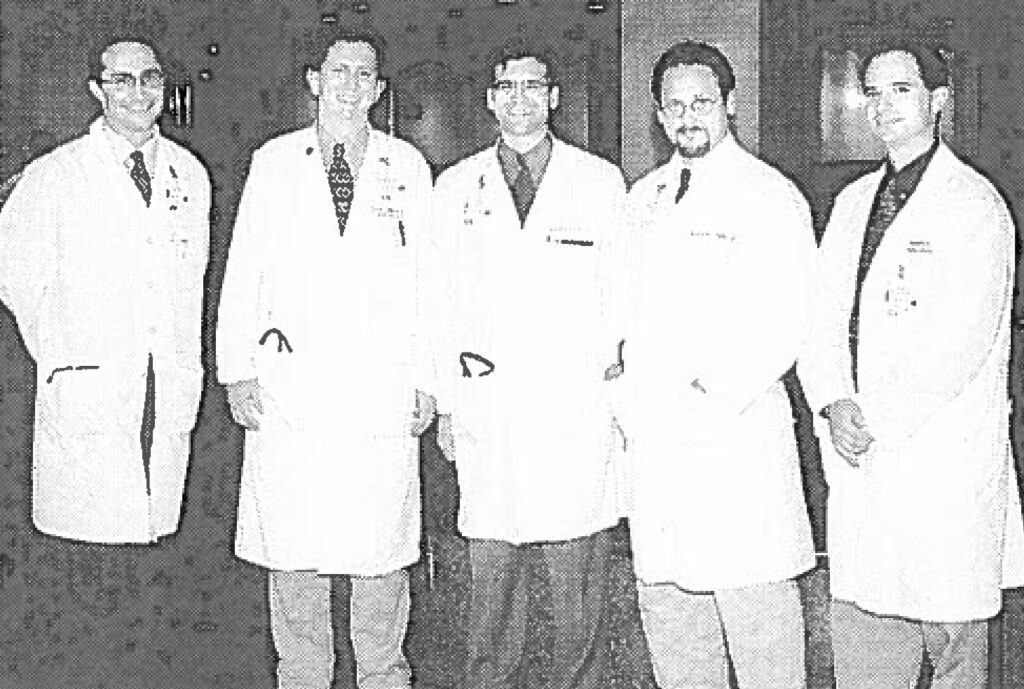
The Division of Hospital Medicine began as a service for admitting physicians to cover their patients in the hospital during absences or other commitments. It has now become one of the fastest-growing divisions in the Department of Medicine and plays a major role not only in providing outstanding care to our inpatients but also in WashU Medicine’s teaching mission. The Division of Hospital Medicine – the youngest in the Department of Medicine – currently has over 100 faculty. This exponential growth mirrors the rapid expansion of the hospitalist movement nationwide.
Origins of the Division
Mark S. W. Thoelke, MD, SFHM, began offering hospitalist coverage for primary care physicians in the late 1990s while he was director of the Gold Service at Barnes Hospital and the Private Medicine Service at the Jewish Hospital in St. Louis. Historically, these services both offered house physician coverage for inpatients, whose primary physicians were still obligated to round daily on their patients. Over time more physicians began to seek autonomous hospitalist-style coverage. With the assistance of Gerald Medoff, MD, Thoelke began a formal hospitalist service under Barnes-Jewish Hospital employment in 1999.
One year later, the Division of Hospital Medicine was organized with the support of Chairman Kenneth S. Polonsky, MD. John P. Lynch, MD, was the divisions first director, with Thoelke serving as the clinical director. This was one of the first hospital medicine divisions in the country. The faculty who comprised the division at the time of initiation also included Robert J. Mahoney, MD, Geoffrey Cislo, MD, Michael Lazarus, MD, and Scott P. Wasserstrom, MD. Thoelke and Mahoney currently remain with the division.
At the time of the division’s creation, there was significant skepticism about the clinical viability of the model and concerns about the financial feasibility. The program was founded “on probation,” and its long-term future would depend critically on its short-term success.
Over the ensuing years, the division has grown in size and responsibilities. During the first year, the division assumed management of the Internal Medicine Consult Service. Consultation services were added at the Rehabilitation Institute of St. Louis in 2002.
The Oncology Division requested assistance with inpatient coverage of a rapidly expanding inpatient service in 2003. Most recently, the Procedure Service was started in 2007 to perform procedures such as thoracentesis and paracentesis, and to provide training to the residents in these procedures.
Hospital Medicine faculty currently attend on roughly half of the teaching service teams. At the same time, the primary hospitalist service has also grown: The number of physicians on-service at one time has increased from three to over one hundred.
Role in education
Hospitalist faculty have become a central component of the residency training program. In addition to the Firm service (the internal medicine teaching service at WashU School of Medicine/ Barnes-Jewish Hospital), hospitalists teach the house staff how to perform bedside procedures on the Procedure Service and how to manage post-surgical patients and perform operative risk assessment on the Medicine Consult Service. Hospitalists contribute to noon conference lectures, Grand Rounds and Clinicopathologic Conferences. The hospitalist service offers a sub-internship experience, which allows a fourth-year student to work directly with an attending to care for inpatients.
Focus on patient safety
Although the focus of the division remains patient care and teaching, hospitalists are at the forefront of promoting patient safety for inpatients at Barnes-Jewish Hospital. Hospitalists lead and serve on many performance initiatives and committees. Hospitalists working on the “front line” offer practical, realistic perspectives to these proceedings.
Future directions
As we move into our third decade, we continue to grow. We have recently expanded our services at Barnes-Jewish West County Hospital. We are focusing on research projects involving improved quality of inpatient care, hospital stays and patient satisfaction.